It served you well for several years, but now it’s time to finally upgrade your TV. Luckily, there are plenty of mid-range options out there to choose from.
In this article, we’ll compare two such mid-range TVs from Sony — X85J vs X90J — and see if the difference is only in the model number or if there is more to it.
X85J vs X90J Overview
When it comes to Sony, you can’t really go wrong when buying a TV, and these two mid-rangers prove it. Both are very solid TVs and are similar in most aspects, though X90J has a few extra features.
Before we take a closer look, let’s compare their main features in the table below:
| Features | Sony X85J | Sony X90J |
|---|---|---|
| Screen Size (in inches) | 43, 50, 55, 65, 75 and 85 inches | 50, 55, 65 and 75 inches |
| Screen Panel | VA Panel | VA Panel |
| Image Processor | 4K HDR Processor X1 | Cognitive XR 4K Processor |
| Operating System | Google TV 10 | Google TV 10 |
| Refresh Rate | 120Hz | 120Hz |
| Variable Refresh Rate | Yes | Yes |
| Resolution | 4K | 4K |
| Contrast Ratio | 6,380: 1 | 5,600: 1 |
| HDMI Ports | 4 | 4 |
| USB Ports | 2 | 2 |
| Wi-Fi and Bluetooth | Yes | Yes |
| Speakers | 20W (2.0 Channels) | 20W (2.0 Channels) |
| Price | Check Price on Amazon | Check Price on Amazon |
Sony X85J

Pros:
- Excellent native contrast
- Very good app selection
- Impressive response times
- Upscales lower resolution content almost perfectly
- 120Hz refresh rate
Cons:
- Doesn’t handle direct reflections very well
- Poor viewing angles
- Lack local dimming
- Can stutter in panning shots
- Scenes in HDR can sometimes be too bright
Sony X90J

Pros:
- Great native contrast
- App selection is varied
- Impressive response times
- 120Hz refresh rate
- Upscales lower resolution content almost perfectly
Cons:
- Poor viewing angles
- Doesn’t handle direct reflections very well
- No wide color gamut support
- Can occasionally stutter in low frame-rate content
Features Face to Face
Now let’s take a closer look at the X85J vs X90J features face-to-face (or should that be screen-to-screen in this case?)
Panel Technology
Both of these models use Vertical Alignment (VA) panel technology.
This means they both have pretty good contrast ratios (6,300:1 for X85J and 5,600:1 for X90J), which makes either an excellent choice for watching a romantic movie with your significant other — for instance, in a dimly lit room.
The downside, like with all other VA TVs, is that both of these TVs have very poor viewing angles, and they also don’t handle reflections very well. So a high-noon game with 10+ friends probably won’t be the best experience for most.
Looking for other types of TV panels? Check out our article comparing IPS, VA, and TN display panel types.
Winner: Draw
Image Processor

These two TVs come with different image processors, and that’s actually the biggest advantage X90J has over X85J. It’s not the only one, though.
Sony X85J comes with the 4K HDR processor X1 inside. This is a solid chip, all things considered, but truth be told — it’s already showing signs of aging, even though it was only released in 2018.
On the other hand, X90J is equipped with the newer Cognitive XR 4K processor, just like most other Sony models after it, such as X95J (good time to check out our article comparing Sony X90J and X95J models).
As you can guess, the biggest difference is in the chip here. The XR chip has a significantly better sharp image processing engine, a wider color gamut, and more light control partitions. It also comes with MEMC motion compensation (basically, it analyzes motion across frames to keep it clear and smooth).
Winner: X90J
Motion Technology
You can expect excellent response times from both of these models, which is one of their main positives.
The X85J has a 100% response time (meaning the time that it takes pixels to transition from one color to the other fully) of 11.7ms and an excellent native refresh rate of 120Hz, plus Variable Refresh Rate (VRR).
In comparison, the Sony X90J has an even better 100% response rate (although not by much, only 1ms for 10.7ms), while it also has a native refresh rate of 120Hz and VRR.
Now, if you’re going to use the TV as a PC monitor, you also need to keep an eye out for input lag.
Here the X85J is actually better with 6.3ms for 1080p@120Hz vs. the 10.7ms that X90J offers, besides the 6.3ms for 4K@120Hz vs. X90J’s 11.1ms, while its input lag for 1440p@60Hz resolution is 15.1ms vs. 18.1ms for X90J.
Here’s the table to get a better understanding:
| Performance features | Sony X85J | Sony X90J |
|---|---|---|
| Refresh rate | 120Hz | 120Hz |
| Variable refresh rate (VRR) | Yes | Yes |
| Response time | 11.7ms | 10.7ms |
| Input lag 1080p @ 120 Hz | 6.3ms | 10.0ms |
| Input lag 4K @ 120 Hz | 6.3ms | 11.1ms |
| Input lag 1440p @ 60 Hz | 15.1ms | 18.1ms |
Winner: X85J
Picture Quality
Of course, most people don’t buy the TV for their processor or how many milliseconds the pixels on the screen take to change color, but for the picture quality itself.
So let’s see how Sony X85J vs X90J fare against each other in this regard.
But first, here are the resolutions they support. The biggest difference is that X90J supports 4K@120Hz@4:4:4 while X85J does not, everything else is the same.
| Resolution | Sony X85J | Sony X90J |
|---|---|---|
| 8K | No | No |
| 4K@144Hz | No | No |
| 4K@120Hz@4:4:4 | No | Yes |
| 4K@120Hz | Yes | Yes |
| 4K@60Hz@4:4:4 | Yes | Yes |
| 4k@60Hz | Yes | Yes |
| 1440p@144Hz | No | No |
| 1440p@120Hz | No | No |
| 1440p@60Hz | Yes (requires forced resolution) | Yes (requires forced resolution) |
| 1080p@144Hz | No | No |
| 1080p@120Hz | Yes | Yes |
| 1080p@60Hz@4:4:4 | Yes | Yes |
Contrast Ratio / Black Level
The contrast ratio represents the ratio between the “whitest” white and the “blackest” black. Did you know they’re called barium sulfate and vantablack?
Anyway, why is this important? Well, a good or bad contrast ratio will show itself if you’re watching a dark scene in a dark room (probably the reason why most people couldn’t see a thing in the “Long Night Episode” of Game of Thrones).
Sony X85J has a slightly better contrast ratio of 6,308:1, while X90J has a contrast ratio of 5,600:1, so the win here goes to X85J.
Winner: X85J
Local Dimming
Local dimming is a very useful feature that allows the native contrast ratio to be enhanced.
Unfortunately, the X85J doesn’t have local dimming as it uses direct backlight.
On the other hand, the X90J does support local dimming thanks to its full-array backlight.
Winner: X90J
Peak Brightness
Peak brightness is the maximum light output capacity that the TV can display within a scene or a frame. Here, we need to distinguish between SDR and HDR peak brightness.
When it comes to Sony X85J, you’re looking at an HDR peak brightness of around 700 nits and 506 nits for SDR peak brightness.
Sony X90J’s HDR brightness, in comparison, “peaks” at 840 nits, while SDR peak brightness is 519 nits.
Winner: X90J
Color
Color volume is excellent on both models, but it’s slightly better on Sony X85J, although this model doesn’t have a complete color gamut and it has a DCI P3 xy of 89.95% and DCI P3 uv of 95.33%, which are both pretty good.
In comparison, the Sony X90J model has pretty good color volume and color gamut itself, though with slightly lower DCI P3 xy and uv values (87.40% and 89.40%).
Winner: X85J
Viewing Angle
Like with other Vertical Alignment (VA) panels, unfortunately, you’re getting poor viewing angles with either Sony model here. Again, IPS panels are much better in this regard.
With both X85J and X90J, you’ll probably notice color washout and shift or brightness loss around 30-35° away from the center.
Perhaps the biggest difference here is in the color shift, where the screen will start to become blueish on X90J as soon as 25°, while on X85J, it will begin to shift at 36°. That’s still not impressive, but at least it’s closer to the 45° mark, which is considered “good.”
Winner: Draw
Reflections / Anti-Glare
In terms of reflections and anti-glare, the two models are virtually almost the same.
They both have total reflections (the amount of light reflected off the screen in either direction) of 5.7%, direct reflection (light reflected from a direct source off the screen) of 5.1%, whereas indirect reflection (the amount of light reflected off the screen in any direction sans direct reflections) of 0.7% (X85J) and 0.6% (X90J).
Winner: Draw
Sound Quality
Both TV models come with a pair of 10 Watts speakers for a total of 20 Watts. Without getting too much into stuff like frequency response (low-frequency extension is 100.79Hz vs 89.80Hz) or distortion, let’s just say that the two models have a “solid if not great sound quality.”
Winner: Draw
Smart Operating Platform (Operating System)
Both Sony X85J and X90J use Google TV 10 as the operating system. This is a very user-friendly operating system that has plenty of apps.
Sony, by the way, is one of only four smart TVs that use Google TV. The other 3 are Philips, TCL and Hisense. Here’s a comparison article we wrote about the latter two: TCL vs Hisense — Which one is better?
Winner: Draw
Connectivity
Inputs
This is another category where the two models are the same.
Both the X85J and X90J have four HDMI 2.0 and two USB 2.0 ports, plus a single port for Digital Optical Audio Out, 3.5mm and Ethernet each.
| Inputs | Sony X85J | Sony X90J |
|---|---|---|
| HDMI Ports | 4 | 4 |
| USB Ports | 2 | 2 |
| Ethernet | Yes | Yes |
| Digital Optical Audio Out | Yes | Yes |
| 3.5mm Jack | Yes | Yes |
Winner: Draw
Voice Assistants

Both models have an integrated Google Assistant and are compatible with Alexa. They come with a TV remote armed with a built-in mic for voice control, which allows you to alter some basic TV settings, like changing the channels, lowering or increasing volume, opening apps, etc.
Winner: Draw
Wireless Technologies
X85J and X90J both support 2.4GHz and 5GHz Wi-Fi, as well as Bluetooth 4.2.
Winner: Draw
Conclusion
Sony X85J and SonyX90J are both very good mid-range TVs, so you won’t make a mistake if you opt for either of them.
However, while the X85J gives the X90J a run for the money and in some cases even beats it, like when it comes to contrast ratio, but the fact that it uses an almost 5-year-old image processor won’t get it many points, which is why we prefer the latter model in our Sony X85J vs X90J comparison.